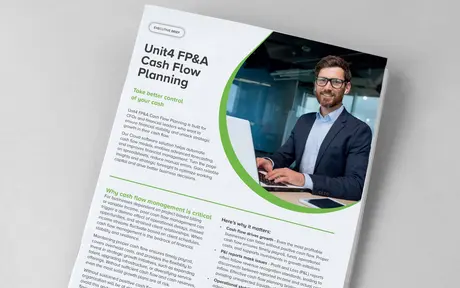How to digitally transform your financial function - Making the journey to FP&A excellence
Unit4’s Business Future Index survey revealed that 69% of finance functions still rely heavily on spreadsheets or data from spreadsheet applications like Excel or Google Sheets.
Legacy systems expose major deficiencies in planning and analysis, leading to unnecessary risk. This is especially clear in recent years: organizations willing to modernize – or who had already undergone digital transformation – found they could respond with agility to disruption.

With continued trends of change, ongoing disruption is likely, and internal pressure from within the organization pushes for modernization. There’s more reason than ever for finance departments to equip themselves with the digital tools they need to automate workflows, integrate data, and weather future disruption.
In this blog, we will look at the steps you can take to set your organization on the journey toward fully transformed modern FP&A capabilities, and how Unit4 can help support a full transformation without disruption.
Keep reading:
4 tips to achieve a successful finance transformation
Digital transformation won’t lead to FP&A Excellence by solely installing an ERP or FP&A system.
Finance teams must plan and develop blueprints for a successful FP&A transformation, along with change management processes. BPM notes in their whitepaper that organizations should only take “the next steps in the FP&A journey that are appropriate to their specific situation”
Here are 4 tips to guide you on your journey to FP&A excellence.

Explore the power of FP&A in minutes
Watch short demos that match your Financial Planning & Analysis priorities – whenever it fits into your schedule.
1. Define the outcomes you want to achieve
Migrating your financial function to a Cloud SaaS solution brings many benefits, such as the ability to streamline processes with automation to reduce errors and data consolidation times. Integrated data in the Cloud can remove data silos and create a single source of data truth.
In the longer term, FP&A transformation creates stronger workflows that lead to robust analysis that benefits the whole organization thanks to advanced reporting capabilities. Process-based FP&A Cloud software can optimize these workflows while also providing extensibility for long-term resilience.
To define success, the CIO and CFO should work together to develop and understand the outcomes they need to transform their capabilities. Naturally, this should be coupled with a detailed change management program to help employees adapt to change as it occurs, ensuring the greatest return of investment, innovation, and time-to-value.
Key outcomes can include, but are not limited to:
- Streamlined processes
- Reduced planning cycle times and faster closing
- Unified systems across the entire finance ecosystem
- Better management reporting and insights
- Company-wide planning capacity that unites everything from your balance sheets and budgeting to workforce planning and revenue performance management.
2. Develop your business case
A strong business case and ROI forecast will help you get other C-suite executives onboard and trust your process. Selling your entire organization on the benefit of a modernized finance function is easy with a business case and will make onboarding easier in the future.
There are several areas where calculating ROI is an easy process, such as clear returns in time spent on manual tasks, and use of FTE hours. An improved workflow can include things like developing forecasts, providing strategic insight across functions, as well as timely generation of detailed reports for stakeholders and other functions.
According to BPM Partners, a unified FP&A software platform conservatively saves 2.5 hours every month in employee time on average.
Based on an assumed hourly rate of $90 per hour (including 30% non-salary costs) – an organization could save $2,700 every year per employee, assuming forecasting is done monthly.
It can be harder to quantify the long-term case for having robust Cloud-based FP&A systems. This includes the ability to be resilient to future disruptions that could occur. Process-based software creates agility and extensibility that is extremely valuable, and not present in legacy systems, but may not be obvious until disruption occurs.
BPM Partners suggest that ROI models account for this resilience by including the expected value that is unlikely to be realized in year 1, but likely to occur in the next 5 years. This includes calculating the potential savings that are made by investing now to build resilience against future business disruptions.
3. Pick your scope and speed
Like any other digital transformation initiative, an FP&A transformation can proceed at varying degrees of speed. BPM suggests thinking in terms of 3 distinct understandings of scope and speed:
-
Transform - A sweeping and comprehensive change that involves the streamlining, optimization, and automation of all your processes and structures. Transitioning the office of the CFO from a static, support-focused planning and reporting function to a strategic advisor in the C-suite.
-
Extend - A widespread change program that takes planning and analysis company-wide, and implements sales performance management, revenue performance management, workforce planning, and supply chain planning and analysis.
-
Evolve - An incremental, step-by-step approach that helps you take the next steps in your journey with controlled and discrete changes – for example increasing your forecasting frequency to implement rolling forecasts, before making the jump to scenario modeling and predictive forecasting.
4. Prepare for continuous improvement
Although the initial phase of your implementation project might only take 1 to 3 months, you should plan for ongoing improvement and extension of your new systems’ capabilities over several years as you consider new use cases and needs.
Once your initial goals are realized, you’ll have to prepare your finance teams for a program of continuous adaptation and change to their processes and technology. What exactly this means will depend on the precise nature, size, and scope of your organization and the needs of the customers you serve.
How can Unit4 help you on the road to FP&A excellence?
In BARC’s Planning Survey, Unit4 FP&A was the leader in ‘Implementer Support’ when compared to other vendors, with 75% of surveyed users rating Unit4’s implementer support for their FP&A product as ‘excellent’ or ‘good’.
As a leader, Unit4 is ranked ahead of all other vendors in this category, as our support ensures a smooth transition from legacy systems to our Cloud-powered FP&A solution.
To learn more about the FP&A transformation process – along with a detailed look at the extent of transformation across industries and the trends driving it – check out BPM’s full whitepaper outlining the road to FP&A Excellence
This asset provides a full checklist for organizations considering digitally transforming their FP&A capabilities, a breakdown of potential transformation roadmaps, and some provocative questions for the future.
To learn more about our FP&A Cloud solution, visit our website, or talk to sales today!







